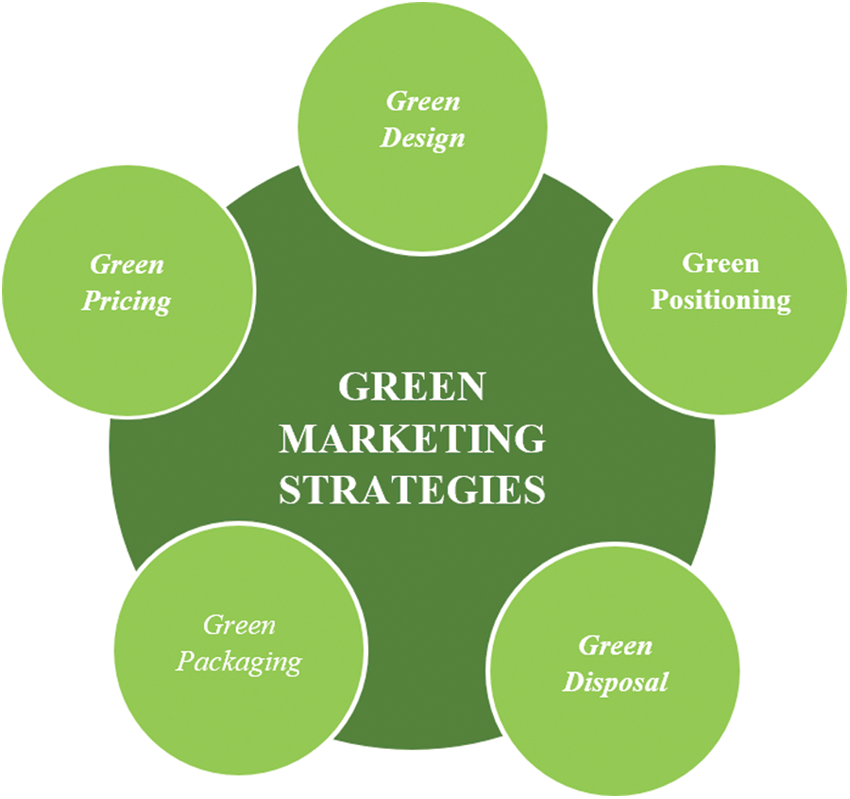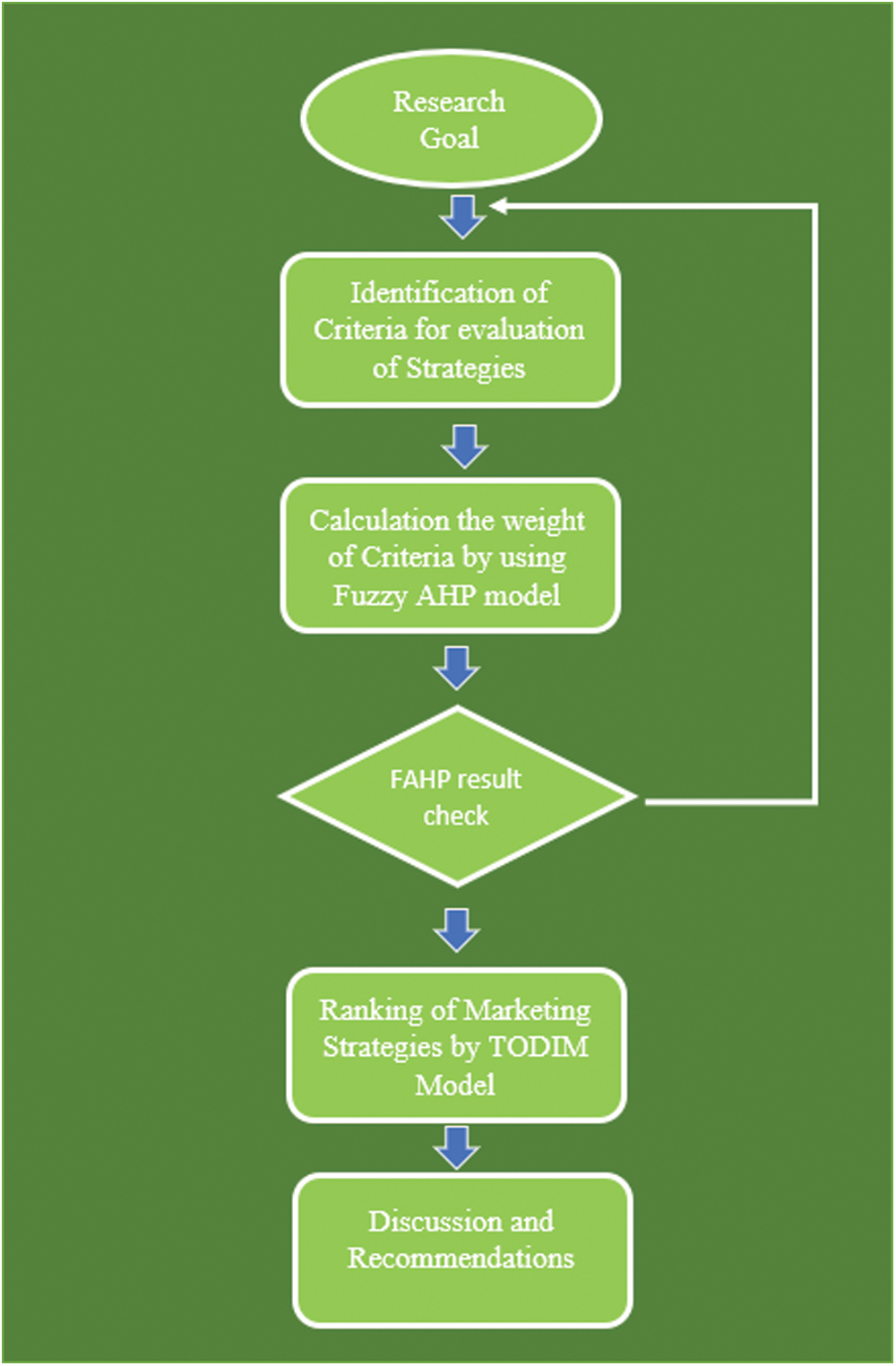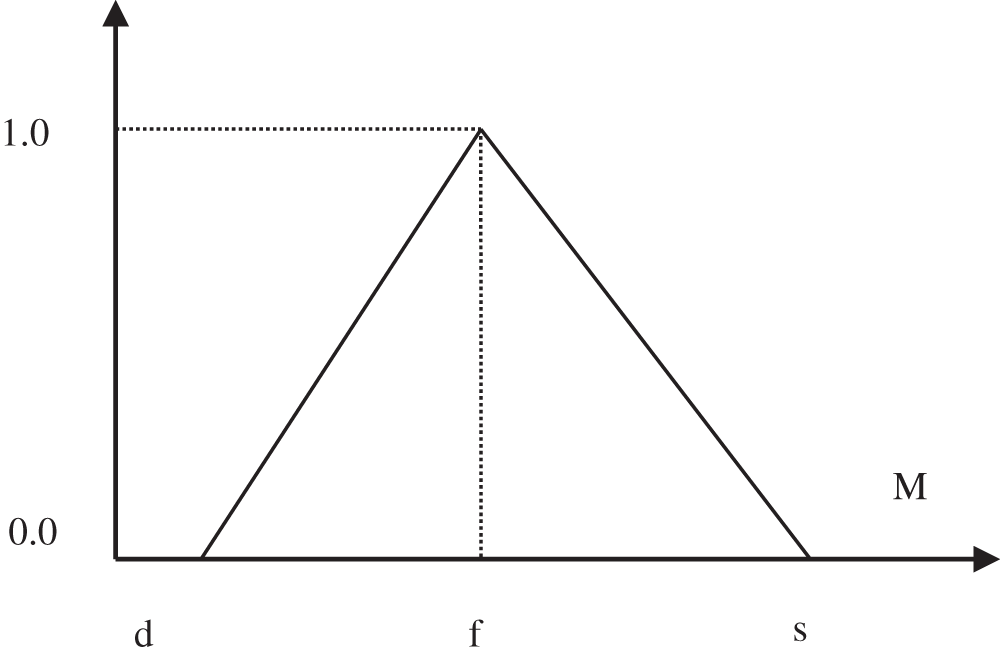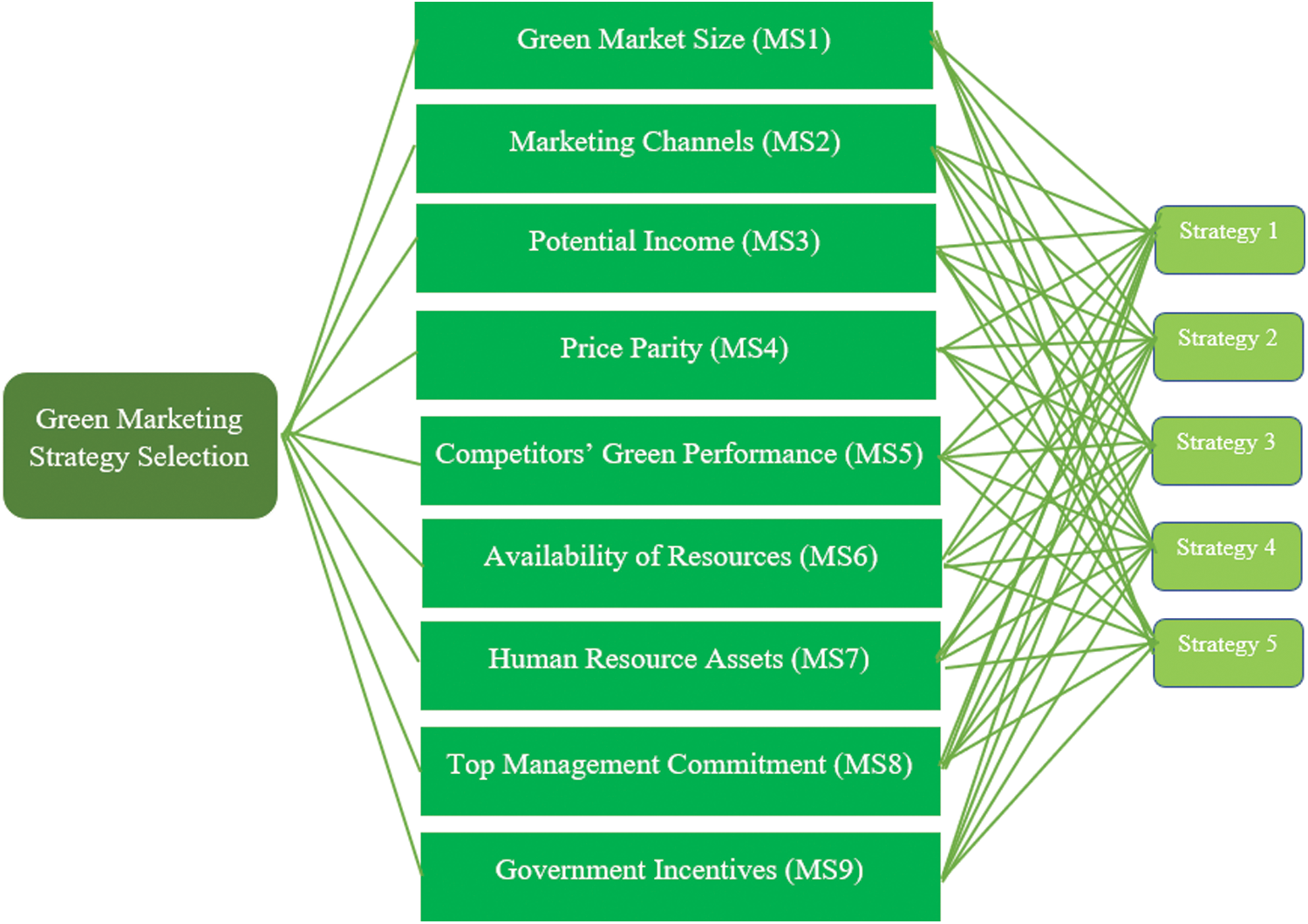| Computers, Materials & Continua DOI:10.32604/cmc.2022.031815 |  |
| Article |
Marketing Strategies Evaluation and Selection for Supply Chain Management Under Uncertainty
Faculty of Commerce, Van Lang University, Ho Chi Minh City, 70000, Vietnam
*Corresponding Author: Nguyen Van Thanh. Email: thanh.nguyenvan@vlu.edu.vn
Received: 27 April 2022; Accepted: 29 May 2022
Abstract: Sustainable marketing, often known as green marketing, has grown in popularity over the last two decades. Government is currently putting pressure to encourage firms to become environmentally aware in multiple aspects like human and financial utilization, advertisement, and product movement. Different types of companies are including many environmental campaigns into their own products to take advantage of the problem. Although many scholars have addressed the relevance of green marketing as well as theory development, this study is unique in that it examines both techniques in a fuzzy context. The integrated Fuzzy Multicriteria Decision Making Model (MCDM) of the analytical hierarchy process (AHP) and a Portuguese-acronymous MCDM method (TODIM) are used to select the best marketing strategy from five alternatives: (i) Green Design, (ii) Green Positioning, (iii) Green Pricing, (v) Green Packaging, and (iv) Green Disposal. based on criteria such as the scale of the green market, price parity, and the commitment of top management. A fuzzy MCDM model for evaluating green marketing strategies was established in the study as contributions for decision-makers in this field under unclarified circumstances. This research also a useful guideline for ranking alternatives in others industry.
Keywords: Green marketing; MCDM model; sustainable; marketing strategy
Green marketing is a positive direction in considering the setting of the environment being seriously damaged and increasing customers’ awareness. Green Marketing isn’t just a passing fad to appease environmentally conscious clients; it also attempts to take genuine activities, communicate important messages, and add real value to the environment [1]. All businesses must evaluate the 4Ps analysis (Product, Price, Promotion, and Place) in normal marketing environment because of the mentioned practice. Green marketers must learn about these new concerns and re-evaluate their marketing mix in an environmentally friendly direction, allowing them to choose the best policy for their company [2].
Nowadays, green marketing is introduced differently compared to traditional marketing and is gaining attention at fast rate where organizations are implementing it within their marketing department. Aside from just normal marketing strategies from traditional marketing methods, green marketing adapts environmentally friendly aspects into the consumers’ mindset which encourage natural resource depletion and atmospheric issues in the environment [3]. Green marketing, according to the American Marketing Association (AMA), is a form of marketing that is favorable to the environment. As a result, Green Marketing is linked to several marketing strategies that influence product rotation, production process changes, packaging approaches, and marketing communication messaging [4]. Companies are devised legal and effective green marketing strategies that avoid the possibility of greenwashing. The following are some of the most successful green marketing tactics (Fig. 1) [5]:

Figure 1: Some of the most successful green marketing techniques
Green Design (strategy 1): When designing, the 3R concept must be followed (Reduction-Reuse-Recycling). (i) Reduction: The product should be developed in such a way that the input materials can be decreased when manufactured or built from environmentally friendly resources. (ii) Reusability; the product can be reused multiple times. (iii) Recycling: The product must be recyclable, which means it can be reused or turned into a substance that can be utilized to build another product [3].
The concept of triple bottom line resolves around profit, people, and planet where each category is considered in all business operations [1]. As supplier selection is a fundamental problem in today’s supply chain, applying this concept assists in the determination of the criteria suitable for the selection process to be smoother.
Green Positioning (Strategy 2): Green positioning aims to strengthen brand associations by providing information about environmentally friendly product features. If the benefits of green branding aren’t effectively communicated, eco-friendly products will fail to be commercially successful. Green positioning (functional and emotional) has two forms of impact on consumer perceptions of a company, similar to brand positioning [5].
Green Pricing (Strategy 3): With the “greener” price, businesses should have a strategy to advertise a green product suitable for users with the same conservation mindset. Intelligent customers will know to save money in the long run by buying products that can be used for a long time compared to one-time purchases [6].
Green Packaging (Strategy 4): Packaging designs often have a minor environmental impact, called sustainable packaging, eco-friendly packaging, or green packaging. To complete designs must reduce a certain amount of packaging waste using sustainable materials (such as packaging that can be reused or biodegraded to reduce waste) and minimize the impact on the environment) and prioritize the use and development of renewable energy sources in the production process. Therefore, implementing this strategy requires consumers and businesses to be conscious of the carbon footprint on the environment [7].
Green Disposal (strategy 5): Green Disposal considers all area of a product’s life cycle, from manufacturing through disposal. Green processing is the recycling of used materials or obsolete products to minimize adverse impacts on the environment and human health, as well as raise awareness about minimizing disposal processes that are not sustainable. Food recycling initiatives and equipment that break down food waste have been impacted by green disposal [5].
In this study, the author uses the Multi-Criteria Fuzzy Decision Model (MCDM) of the fuzzy analytical hierarchy process (Fuzzy AHP) combined with a Portuguese method to support the output technique (TODIM). The study’s objective was to be based on a case study to suggest an appropriate marketing strategy for a green product manufacturer. All the criteria in this model will determine the appropriate weights in the first step using the AHP model combined with fuzzy theory. The TODIM technique is widely used in many fields such as industrial economics, commerce, or management science to investigate problems in decision-making by attribute group (MAGDM). TODIM is used in the final stage to rank five green marketing strategies.
The purpose of this study is to integrate the original TODIM model with fuzzy AHP to solve difficulties related to marketing strategy selection.
Researchers consider the Multicriteria Decision Making (MCDM) problem to be one of the most popular treaties in the literature. Several approaches are based on the MCDM method that has been used or combined with other methods in MCDM/MCDA or other suitable strategies, so there are many approaches to deal with this problem decision-making process [8].
To come up with a suitable green marketing strategy to promote new green products based on four options: (i) Green Slant, (ii) Green Defensive, (iii) Green Translucent Glossy, and (iv) Green Extreme, Akansha Jain et al. used an integrated methodology of Fuzzy Analytical Process (FAHP) and Fuzzy Technique for the order of preference according to the similarity to the ideal solution (F-TOPSIS) [9]. The author used AHP to calculate the weight of criteria in this study, and the TOPSIS method to rank some marketing methods [10].
Wu et al. [11] proposed to combine the analytical network process (ANP) with the technique for order preference by similarity to an ideal solution (TOPSIS) that marketing strategists can apply to find a solution. method or recommend a product marketing plan in the best way. For selecting a marketing strategy, Mohaghar [12] introduced a new approach to choosing marketing strategies by integrating Fuzzy AHP and VlseKriterijumska Optimizacija I Kompromisno Resenje in the Serbian model (VIKOR). This model can efficiently set weights in multiple criteria of a hierarchy. To find the fuzzy weight of the criteria, the author used the Fuzzy AHP method and the VIKOR model to rank strategies against the criteria in the first stage. Büyüközkan et al. [13] developed an integrated fuzzy approach to identify the right marketing strategy through AHP and VIKOR methods.
Girubha et al. [14] present a study on the use of interpretive structural modeling (ISM) in conjunction with MCDM methodologies to enable the selection of sustainable suppliers. In this study, the author employed the analytic network process (ANP), ELimination and Et Choice Translating REality (ELECTRE II), and Vlse Kriterijumska Optimizacija Kompromisno Resenje MCDM models to rank some possible suppliers (VIKOR). Tzeng et al. [15] combined various MCDM techniques such as Decision Making Testing and Evaluation Laboratory (DEMATEL) techniques, Analytical Network Processes (ANP), Gray Relational Analysis (GRA), and VlseKriterijumska Optimizacija I Kompromisno Resenje (VIKOR) to select and reconfigure global production and logistics systems.
TODIM method enterprise resource planning (ERP) software selection was used by Yigit Kazancoglu and Serhat Burmaoglu [16]. For decision makers in numerous industries, including manufacturing organizations, a new approach toward ERP software selection has been devised. In the study of Erkan Celik et al., the author proposed a model using the Best-Worst methodology (BWM) and TODIM techniques to an upgraded fuzzy concept of interval type 2 fuzzy sets (IT2FSs) to provide a decision process and determining multi-criteria to select green suppliers in the field of textiles. The study identified the most critical sub-criteria in the textile sector, including dye and print quality, profit per product, price volatility, product design, and pattern compatibility or cost purchase [17].
TODIM was used by Tseng et al. [18] to evaluate green supply chain operations in the face of uncertainty. This research found a collection of key factors that can have a systematic and wide-ranging impact on strategic direction recommendations. In the work of Zhang et al., a real-time slicing model based on a finite element and order reduction approach was presented to increase productivity and assure computing speed and real-time performance. In another scientic research, they used a quick and precise circuit modeling model based on the point primitive approach [19,20].
3.1 Spherical Fuzzy Sets Theory
The evaluation and selection of green marketing strategies is a multi-criteria problem involving both qualitative and quantitative considerations. In this study, the authors combined a fuzzy analytical hierarchical process (Fuzzy AHP) with a method in Portuguese for technical analysis interactive multi-criteria decision making (TODIM) to offer a new model to support green product marketing choices. In this model, there are three steps in the decision-making process shown in Fig. 2:
Step 1: Using experts and literature research, identify criteria for evaluating green marketing initiatives.
Step 2: Identification the weight of all criteria by using Fuzzy Analytical Hierarchy Process (FAHP).
Step 3: The TODIM model is an MCDM tool that is used to rank and assess green marketing tactics.

Figure 2: Flowchart of research methodology
TFN is understood as (d, f, s), where the parameter to determine the least possible value, the most potential value, and the highest possible value is d, f, and s (d ≤f ≤ s). Fig. 3 shows the TFN and classification as follows:

Figure 3: Triangular fuzzy number
The following is an example of a fuzzy number.
The respective representations of a fuzzy number for its left and right are
3.3 Fuzzy Analytical Hierarchy Process Model
The Fuzzy Analytical Hierarchy Process (FAHP) is considered a fuzzy variant of the Analytical Hierarchy Process (AHP) to propose solutions to address the limitations of the AHP model for decision-making in uncertain environments. In this model, K and the set of objects are considered as the set of targets, and the authors perform degree analysis using Chang’s degree analysis method [21]. The collected results are the values when analyzing the level of each object presented as follows:
where
Determine the value of the fuzzy composite level of the
The possibility that
We have
Convex fuzzy numbers in fact are
And
The convention d is the symbol for the coordinates of the highest point of intersection E between
Use
Calculate the values of
The probability of a convex fuzzy number greater than k is defined as
and,
On the assumption that:
for
Determine
The representation of normalized weighted vectors is as follows:
The number W is a nonfuzzy number.
Evaluate the Saaty’s matrix to determine its consistency.
The TODIM technique (Interactive and Multi-Criteria Decision Making in Portuguese) is more developed than in the early 1990 s, and it is a multi-criteria method based on Prospect Theory. The TODIM method includes the following main stages [22]:
Stage 1: Construct a decision-making matrix.
Stage 2: All of the criteria’s cumulative weights must equal 1:
Stage 3: Quantitative criteria scales need to be standardized so that values or results can be compared, and similar quantitative scales can be used to standardize these estimates. The model optimizes the criteria, and a set of Eqs. (17)–(19) is used, which includes Eq. (16) and Eq. (17) which are used to minimize the criterion and normalize respectively values.
Eq. (18) reduces the higher values to smaller ones, giving greater weight to the lower starting alternative predictions. Eq. (19) is used to normalize the new values:
Stage 4: Recalculate the individual criterion weights using the criterion of most important (criterion
Stage 5: Each criterion
Stage 6: The total of “single-criteria dominance” assessments for each pair of options are
Stage 7: The “global overview” G(
Stage 8. At the final stage, “ in order to obtain “the relative population value V(
Eq. (24) is used to rank the ordinal alternatives in the “relative overall values” between 0 and 1 generated from the above equation.
Green marketing refers to product and service marketing initiatives that are focused on environmental considerations or attitudes. The use of hazardous materials should be limited and replaced with the use of renewable materials, products that can be repaired or reused many times, or reduced packaging should be mentioned and raise awareness in the production process as well as green marketing with environmentally friendly characteristics [23].
In this study, the author proposes a Multi-Criteria Decision-Making Model (MCDM), including FAHP and TODIM models, to assist managers and businesses in determining the appropriate green marketing strategy in unclear environments. In this model, after surveying opinions from senior management based on collected documents and evaluating individual expectations, seven criteria are selected based on research methods mentioned in Section 3. The list of criteria that have a particular influence on decision-making is shown in Fig. 4 as follows:

Figure 4: Structure of FAHP model
The author mixes fuzzy theory with the AHP model in the first stage of this study to determine the weight of all criteria, with the findings displayed in Tab. 1.

In the final stage, TODIM model is employing for ranking green marketing strategies. Normalized matrix and Sum of single criterion dominances [δ(ai, ak)] from TODIM model are shown in Tabs. 2 and 3.


The authors conducted a real-world case study using the above methods, including nine evaluation criteria businesses have applied to implement the best green marketing strategies. Result Tab. 4’s findings showed that green designs have an eco-friendly coefficient and customer accessibility of 1.0, which is the maximum for this model and suggests a perfect strategy for businesses.

Green marketing is a continuous process that includes involvement from suppliers, government policies, and the public. This is required for green marketing techniques to be adopted by the target market and so obtain a long-term competitive advantage.
Therefore, businesses need to build for themselves an effective business strategy towards the goal of sustainable development, especially in the selection of marketing strategy. The evaluation and selection of a green marketing strategy is a multi-criteria choice in which the decision maker must weigh several qualitative and quantitative criteria, some of which may clash with one another, to choose the best plan. The combination of the fuzzy hierarchical analysis process (Fuzzy AHP) and a Portuguese method for interactive multi-criteria decision making (TODIM) has created an integrated fuzzy multi-criteria decision model novel combination (FMCDM) to suggest the most suitable green marketing strategy for businesses. This research is the first marketing strategy evaluation and selection model in Vietnam by interviewing experts and reviewing the literature. This study is the first study to provide a case study on evaluating marketing strategy utilizing the model proposed by the combination of FAHP and TODIM models.
Funding Statement: We are greatly thankful to Van Lang University, Vietnam for providing the budget for this study.
Conflicts of Interest: The authors declare that they have no conflicts of interest to report regarding the present study.
References
1. Cong Ty TNHH The 7, “Xu hướng marketing xanh–làn gió mới trên thị tru‘ò‘ng việt Nam,” 2020. [Online]. Available: https://the7.vn/xu-huong-digital-marketing/xu-huong-marketing-xanh-lan-gio-moi-tren-thi-truong-viet-10351/. [Google Scholar]
2. K. Peattie, Green Marketing M and E Handbooks, 1st ed., New York City, United States: England, Pitman Publishing, 1992. [Google Scholar]
3. Vietnam Logistics Review, “Chiến lược marketing xanh,” 2020. [Online]. Available: https://vlr.vn/logistics/news-3123.vlr. [Google Scholar]
4. American Marketing Association, “Definitions of marketing,” 2020. [Online]. Available: https://www.ama.org/the-definition-of-marketing-what-is-marketing/. [Google Scholar]
5. Enabling Extraordinary Entrepreneurship, “Green marketing,” 2020. [Online]. Available: https://www.e2exchange.com/articles/5-effective-green-marketing-strategies/. [Google Scholar]
6. ATP Holdings, “Green marketing là gì? hiệu quả cűa marketing xanh trong thực Tiễn,” 2020. [Online]. Available: https://atpholdings.vn/green-marketing-la-gi-hieu-qua-cua-marketing-xanh-trong-thuc-tien/. [Google Scholar]
7. Nossiue, “What is green packaging?,” 2020. [Online]. Available: https://noissue.co/blog/blog-what-is-green-packaging/. [Google Scholar]
8. V. Schramm, L. Cabral and F. Schramm, “Approaches for supporting sustainable supplier selection-a literature review,” Journal of Cleaner Production, vol. 273, pp. 123089, 2020. [Google Scholar]
9. A. Jain, J. D. Darbari, A. Kaul and P. C. Jha, “Selection of a green marketing strategy using MCDM under fuzzy environment,” Soft Computing for Problem Solving, vol. 11, pp. 499–512, 2020. [Google Scholar]
10. R. Yousefi, “An integration of MCDM methods for marketing strategy selection,” Global Journal of Management Studies and Researches, vol. 3, no. 3, pp. 96–11, 2016. [Google Scholar]
11. C. S. Wu, C. T. Lin and C. Lee, “Optimal marketing strategy: A decision-making with ANP and TOPSIS,” International Journal of Production Economics, vol. 127, no. 1, pp. 190–196, 2010. [Google Scholar]
12. A. Mohaghar, M. R. Fathi, M. K. Zarchi and A. Omidian, “A combined VIKOR-fuzzy AHP approach to marketing strategy selection,” Business Management and Strategy, vol. 3, no. 1, pp. 13, 2012. [Google Scholar]
13. G. Büyüközkan, E. Mukul and D. Uztürk, “Marketing strategy selection for logistic companies,” XIV Int. Logistics and Supply Chain Congress, Turkey, pp. 437–445, 2016. [Google Scholar]
14. J. Girubha, S. Vinodh and K. E. K. Vimal, “Application of interpretative structural modelling integrated multi criteria decision making methods for sustainable supplier selection,” Journal of Modelling in Management, vol. 11, no. 2, pp. 358–388, 2016. [Google Scholar]
15. G. H. Tzeng and C. Y. Huang, “Combined DEMATEL technique with hybrid MCDM methods for creating the aspired intelligent global manufacturing & logistics systems,” Annals of Operations Research, vol. 197, no. 1, pp. 159–190, 2012. [Google Scholar]
16. Y. Kazancoglu and S. Burmaoglu, “ERP software selection with MCDM: Application of TODIM method,” International Journal of Business Information Systems, vol. 13, no. 4, pp. 435–452, 2013. [Google Scholar]
17. E. Celik, M. Yucesan and M. Gul, “Green supplier selection for textile industry: A case study using BWM-TODIM integration under interval type-2 fuzzy sets,” Environmental Science and Pollution Research, vol. 28, no. 45, pp. 64793–64817, 2021. [Google Scholar]
18. M. L. Tseng, Y. H. Lin, K. Tan, R. H. Chen and Y. Chen, “Using TODIM to evaluate green supply chain practices under uncertainty,” Applied Mathematical Modelling, vol. 38, no. 11, pp. 2983–2995, 2014. [Google Scholar]
19. X. Zhang, W. Zhang, W. Sun, H. Wu, A. Song et al., “A Real-time cutting model based on finite element and order reduction,” Computer Systems Science and Engineering, vol. 43, no. 1, pp. 1–15, 2022. [Google Scholar]
20. X. Zhang, H. Wu, W. Sun, A. Song and S. K. Jha, “A fast and accurate vascular tissue simulation model based on point primitive method,” Intelligent Automation & Soft Computing, vol. 27, no. 3, pp. 873–889, 2021. [Google Scholar]
21. D. Y. Chang, “Extent analysis and synthetic decision,” Optimization Techniques and Applications, vol. 1, pp. 352, 1992. [Google Scholar]
22. A. Ruzgys, R. Volvačiovas, C. Ignatavičius and Z. Turskis, “Integrated evaluation of external wall insulation in residential buildings using SWARA-TODIM MCDM method,” Journal of Civil Engineering and Management, vol. 20, no. 1, pp. 103–110, 2014. [Google Scholar]
23. Vietnam Biz, “Marketing xanh (green marketing) là gì? Hiệu quả cűa marketing xanh trong thực tiễn,” 2021. [Online]. Available: https://vietnambiz.vn/marketing-xanh-green-marketing-la-gi-hieu-qua-cua-marketing-xanh-trong-thuc-tien-20191017105814893.htm. [Google Scholar]
 | This work is licensed under a Creative Commons Attribution 4.0 International License, which permits unrestricted use, distribution, and reproduction in any medium, provided the original work is properly cited. |